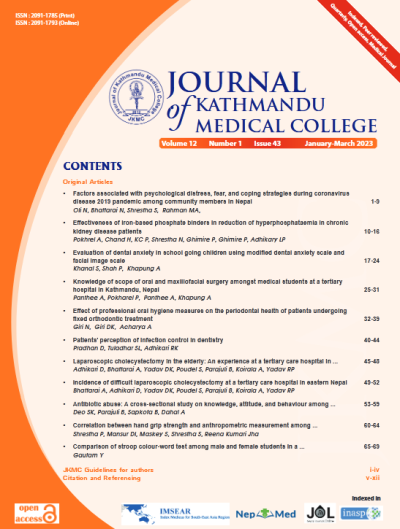Evaluation of dental anxiety in school going children using modified dental anxiety scale and facial image scale
DOI:
https://doi.org/10.3126/jkmc.v12i1.56688Keywords:
Dental fear anxiety, Facial image scale, Modified dental anxiety scaleAbstract
Background: Dental anxiety refers to patient’s response toward stresses associated with dental procedures. It can present problem for both dentist and patient, particularly in paediatric dentistry. Hence, it is important to identify anxious patients for improved patient management and development of better treatment strategies.
Objectives: To evaluate the prevalence of dental anxiety in schoolchildren using Modified Dental Anxiety Nepali version (MDAS-N) and Facial Image Scale (FIS).
Methods: An analytical cross-sectional study was carried out in 401 schoolchildren (11.34 ± 1.85 years) using convenience sampling method from 2022 June to 2022 August after ethical approval was obtained from Nepal Medical College. The dental anxiety was assessed by questionnaire provided in MDAS-N and FIS. Independent t-test was done in SPSS v.20.0 to analyse the data.
Results: The data have shown that 375 (93.52%) had dental anxiety (mean MDAS-N = 11.83 ± 3.59) with low and moderate anxiety in 153 (38.15%) and 140 (34.92%) respectively. Seventy (36.08%) females presented with moderate anxiety and 92 (44.44%) males had low anxiety. The mean score difference was statistically significant (p-value <0.001) between the genders. Statistically significant difference (p-value = 0.023) was found between FIS mean score of primary and middle school level students. Injection and drilling the tooth were the procedures with high anxiety score in both scales. There was a moderate positive correlation between MDAS-N and FIS (r = 0.574).
Conclusion: Assessing dental anxiety and factors provoking fear and anxiety in dental clinic is useful, as behaviour management can be applied accordingly for child patients.
Downloads
Downloads
Published
How to Cite
Issue
Section
License

This work is licensed under a Creative Commons Attribution-NonCommercial 4.0 International License.
Copyright © Journal of Kathmandu Medical College
The ideas and opinions expressed by authors or articles summarized, quoted, or published in full text in this journal represent only the opinions of the authors and do not necessarily reflect the official policy of Journal of Kathmandu Medical College or the institute with which the author(s) is/are affiliated, unless so specified.
Authors convey all copyright ownership, including any and all rights incidental thereto, exclusively to JKMC, in the event that such work is published by JKMC. JKMC shall own the work, including 1) copyright; 2) the right to grant permission to republish the article in whole or in part, with or without fee; 3) the right to produce preprints or reprints and translate into languages other than English for sale or free distribution; and 4) the right to republish the work in a collection of articles in any other mechanical or electronic format.




